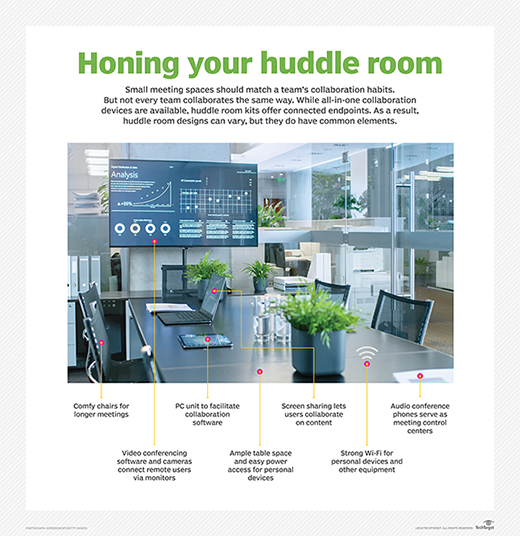Maximize huddle room technology with collaboration metrics
Organizations should use collaboration metrics with their huddle room technology to measure employee productivity and the effectiveness of collaboration technologies.
Huddle room technology continues to advance along with broader digital transformation trends in the workplace. In terms of enterprise collaboration, this audiovisual advancement means adopting more flexible models for the workspaces and tools workers need.
Conventional large conference rooms and technology are still needed in the enterprise to support large group and scheduled meeting needs. huddle rooms, on the other hand, address the needs of smaller groups and shorter, ad hoc meetings.
As organizations strive to become more agile, employees need to work in teams more often. For teams to be productive, the overall experience needs to be easy. However, you also need to measure performance while working in this mode, and the metrics surrounding huddle room workflows are still evolving.
Employee demand for huddle rooms can be hard to predict, and comparing the usage rate of formal, large conference rooms may not be a valid indicator of what to expect. IT will certainly need collaboration metrics to track the adoption of huddle room technology. This includes usage rates of huddle rooms and the applications used to collaborate, such as video conferencing or mobile devices. IT should also track the number of attendees per meeting, the duration of meetings and the level of engagement with outside parties.
Another area to measure will be network use so IT can ensure adequate resources are available when teams use audio and video conferencing tools when meeting in huddle rooms. Over time, these metrics will indicate how many rooms are needed, the overall UX with huddle room technology and what forms of IT support and integrations are required. These are fairly straightforward metrics to track, but metrics around team performance must also be considered for huddle room technology success.

Develop enterprise collaboration metrics
Collaboration metrics around team performance are not well established but can be evaluated on three levels: individual performance, team performance and overall effect on the organization. Several metrics can be easily tracked while teams are working in huddle rooms to indicate how well each member is contributing.
One metric, for example, would be how many ideas each person contributes to the collaborative process and how many are actually accepted by the group. Another would be how well team members meet the targets for their tasks. Performance metrics like these will show how well workers do in team settings.
Since everything is digital in this environment, these interactions can be captured and recorded. In time, you'll be able to measure the quality of everyone's contribution. The exact metrics will vary by the type of business, but the bigger picture is more important.
Measuring performance should support the business case of huddle room technology to encourage sharing and faster decision-making. The more you can show huddle room performance metrics -- compared to similar metrics for larger meeting spaces -- the more receptive employees will be to working in huddle rooms. A good UX is critical to driving usage of these spaces. Using collaboration metrics to support the UX will prove to employees the appeal of huddle rooms and maximize the value of your huddle room technology investment.







